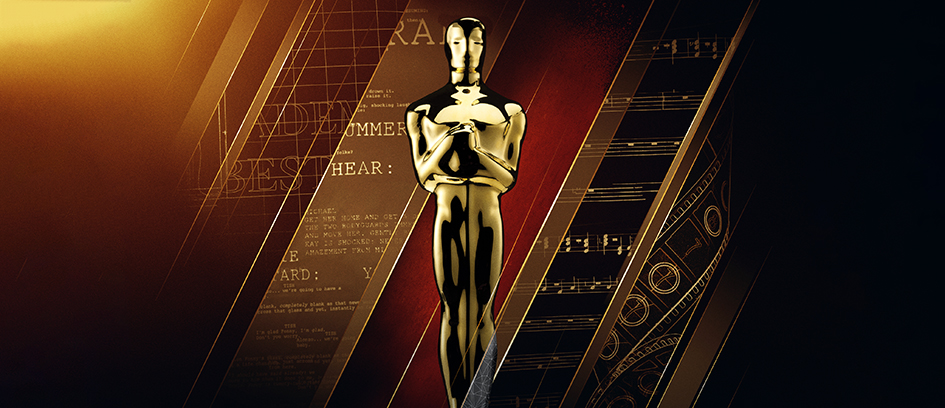Oscar Categories: What Do They Mean?

By now you probably know the films and performances nominated in the Big Five Oscar categories (Best Picture, Director, Actor, Actress, and Screenplay), but how much do you know about the other awards? Some are straight forward, like Best Original Song or Best Animated Feature, but there are others that may not be as obvious.
As Background Actors, it's important to know who you're working with and how everyone contributes to the finished product. There are many people behind the scenes who you may never meet, but have an impact on your role on set. To help you understand some of these crew members, we explain five Oscar categories you may not be familiar with.
Best Cinematography
On a basic level, cinematography is capturing visuals on film, but what cinematographers contribute to filmmaking goes far beyond that. Oscar nominated cinematographer Rodrigo Prieto says cinematography is not just about creating beautiful visuals, but telling "emotional stories with images." Cinematographers (also known as director of photography or DP) collaborate with the director to plan each shot and decide which lenses, filters, and lighting are necessary to achieve their desired look. So not only are cinematographers trying to capture a scene, they're bringing visuals to life to serve the story and the director's vision.
Best Production Design
Production designers are responsible for setting the stage for a scene. They oversee the design, creation, and dressing of sets, locations, and props to not only realize the director's vision, but to help establish a project's tone. As the head of the art department, production designers also work with the costume, hair, and make-up departments to create a cohesive and complimentary look for the film. According to production designer Kathy Altieri, production design has to "move you and transport you to a place you become immersed in."
The category was originally called Best Art Direction, but was changed to Best Production Design in 2012 after the Art Directors Branch of the Academy changed their name to the Designers Branch.
Best Costume Design
The clothes we wear everyday are a reflection of our personality and can say a lot about our mood and social status. Part of a costume designer's job is to take the information they have about a character and use clothing to help show us who that character is. One of the challenges they face is staying true to the aesthetic and tone of the film while still creating unique styles for each character. Costume designers work closely with the production designer, director, and DP to make sure the costumes fit the overall vision of the film.
While costume design may sound like it's for period or specialized wardrobe, it actually refers to all clothing worn in a film, whether it's period or modern. For films where production provides wardrobe for Background Actors, the costume designer is responsible for designing their clothing and collaborating with the wardrobe department to ensure all background have the correct look.
Best Sound Editing
Oscar winning sound editor Walter Murch estimates that 98% of all sound in a film is added in post-production because the focus during filming is mostly to get the visuals and dialogue recorded (dialogue is also added in post through automated dialogue replacement, also known as ADR). Sound editing is the recording and creation of all sounds used in a film (except for music) and involves recreating sounds that weren't picked up on set (like footsteps) and sounds that don't exist (like the whoosh of a lightsaber).
One technique used for making sound effects is Foley. Some sounds are hard to authentically capture for film, like clothes brushing together or crackling fire, so Foley artists use other materials to mimic these noises. For example, to recreate the crunch of snow, Foley artists may fill a leather pouch with corn starch and step on it to produce the same noise.
Best Sound Mixing
Once the effects have been recorded, they need to be added to the visuals and music. Sound mixing is the blending of all these sounds in a cohesive and believable way. The process often involves layering multiple sounds, like dialogue, music, and effects, and adjusting the levels so they fit the action of the scene. Think of beach party. You have the sound of the waves, music, talking, a bonfire, and people playing beach volleyball. All of these sounds exist at once, but depending on where the characters are in the scene, some sounds are more pronounced. Say the character is walking along the water, the sound of the waves will be louder than the crackling of the bonfire, but needs to be at a level where the viewer can still comfortably hear the dialogue and the party noise in the background.
If you've been booked as part of a walla group by Central Casting, then you've been part of this process and maybe didn't know it. The sound editors record the walla tracks then hand them off the to the sound mixers who layer them into the rest of the film's audio.
Sound editing and sound mixing are two separate Oscar categories, but are presented back to back at the ceremony and often share many of the nominees.
Want to learn more about the Academy Awards? We've got you covered with our articles How Film Festivals Influence the Oscars and The Oscars: A History of Hollywood's Biggest Night.